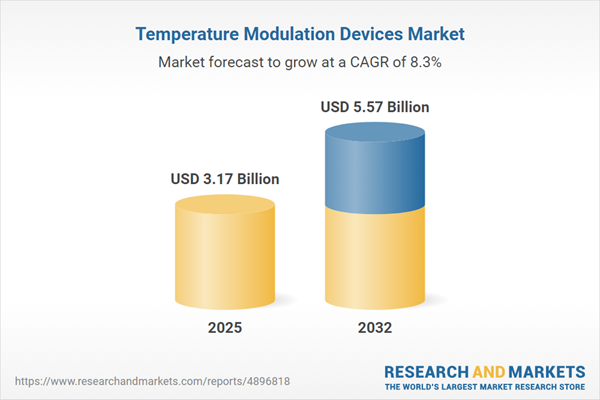Speak directly to the analyst to clarify any post sales queries you may have.
As enterprises pursue digital transformation and enhanced sustainability, the temperature modulation devices market is rapidly evolving. Senior decision-makers face increasing pressure to ensure operational resilience, align with shifting standards, and select the right technological partners for reliable thermal management.
Market Snapshot: Temperature Modulation Devices Market Size and Growth
The temperature modulation devices market demonstrates robust momentum, marked by significant value increases and a strong compound annual growth rate. This expansion is supported by heightened demand from sectors such as automotive, electronics, healthcare, and energy. Companies in these industries are actively seeking advanced solutions for precise thermal control, maintaining operational continuity, and complying with global regulatory standards. Technological innovation, broader adoption, and more stringent policies are driving maturity across both mature and emerging markets. The resulting dependency on reliable thermal management reinforces the strategic importance of this sector for maintaining efficiency in diverse operating environments.
Scope & Segmentation of the Temperature Modulation Devices Market
- Device Types: Heat pipes, heat sinks, liquid cooling systems, phase change materials, and thermoelectric coolers, each designed for unique operational settings and thermal challenges.
- Cooling Technologies: Oil cooling, refrigerant and water-based systems, gas compression, phase change material packs, magnetocaloric technology, and thermoelectric approaches, which enable configurable solutions for a range of application loads.
- Application Industries: Automotive, consumer electronics, data centers, healthcare, and industrial manufacturing, with each sector requiring tailored thermal solutions for equipment reliability and regulatory needs.
- End Users: Commercial businesses, healthcare providers, industrial organizations, and residential users, illustrating broad market penetration and an impact on mission-critical systems and product longevity.
- Sales Channels: Offline and online retail, direct sales, and distributor networks, providing procurement flexibility to accommodate both traditional and digital purchasing preferences.
- Regions: Americas (North America, Latin America), EMEA (Europe, Middle East, Africa), and Asia-Pacific, where adoption is influenced by local supply chain strategies and operational requirements that shape technology deployment and customization.
- Key Manufacturers: Leading companies such as Honeywell International Inc., Johnson Controls International plc, Carrier Global Corporation, Trane Technologies plc, Siemens AG, Schneider Electric SE, Emerson Electric Co., Danfoss A/S, Robert Bosch GmbH, and Mitsubishi Electric Corporation, all recognized for advancing offerings and adapting to evolving industry demands.
Key Takeaways for Decision-Makers
- Temperature modulation devices support critical operations in core industries by enhancing operational efficiency and simplifying compliance with updated environmental and performance standards.
- Emerging materials, such as those used in phase change applications and solid-state systems, are enabling environmentally responsible management and fostering new device development.
- Integration of digital sensors and advanced connectivity facilitates the transformation of conventional thermal systems into adaptive platforms, providing greater system reliability through real-time insights and predictive maintenance.
- Collaboration between manufacturers and OEMs streamlines time-to-market and enables smoother technology integration, notably for sectors like electric vehicles and large-scale data centers.
- Expanded procurement channels, including aftermarket and OEM supply, improve market responsiveness and allow for regionally tailored customer solutions.
Tariff Impact: Navigating U.S. Trade Policy Shifts
- Recent U.S. tariffs have led to higher manufacturing costs, prompting companies to reconfigure supply chains and prioritize sourcing strategies that boost resilience, such as domestic or nearshore options.
- To offset tariff-related pressures and maintain product quality, organizations are adopting flexible production methods and considering alternative materials.
- Procurement functions increasingly rely on transparency and advanced analytics to protect margins and ensure adaptability during uncertain trade periods.
Temperature Modulation Devices Market Methodology & Data Sources
Research is based on a combination of primary interviews with industry leaders, extensive literature reviews, quantitative sector surveys, and data validation using trade and production databases. This comprehensive structure delivers reliable findings designed for use in strategic planning initiatives.
Why This Report Matters for Senior Decision-Makers
- Enables informed investment and product strategies through segmented analysis and clear technology pathways tailored to the temperature modulation devices market.
- Equips teams to manage risk and supply chain decisions as regulations and trade policies evolve.
- Delivers granular intelligence for more precise market expansion or entry strategies, aligned with the requirements of specific regional markets and industries.
Conclusion
Temperature modulation devices remain central as innovation and regulatory dynamics reshape industry expectations. This report offers a trusted basis for planning and strategic decision-making in a rapidly shifting environment.
Additional Product Information:
- Purchase of this report includes 1 year online access with quarterly updates.
- This report can be updated on request. Please contact our Customer Experience team using the Ask a Question widget on our website.
Table of Contents
3. Executive Summary
4. Market Overview
7. Cumulative Impact of Artificial Intelligence 2025
List of Figures
Samples

LOADING...
Companies Mentioned
The key companies profiled in this Temperature Modulation Devices market report include:- Honeywell International Inc.
- Johnson Controls International plc
- Carrier Global Corporation
- Trane Technologies plc
- Siemens AG
- Schneider Electric SE
- Emerson Electric Co.
- Danfoss A/S
- Robert Bosch GmbH
- Mitsubishi Electric Corporation
Table Information
| Report Attribute | Details |
|---|---|
| No. of Pages | 193 |
| Published | October 2025 |
| Forecast Period | 2025 - 2032 |
| Estimated Market Value ( USD | $ 3.17 Billion |
| Forecasted Market Value ( USD | $ 5.57 Billion |
| Compound Annual Growth Rate | 8.3% |
| Regions Covered | Global |
| No. of Companies Mentioned | 11 |









